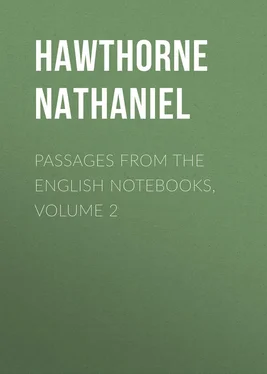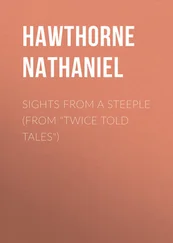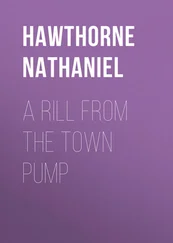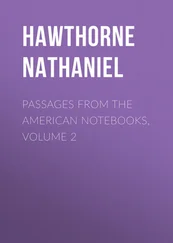Nathaniel Hawthorne - Passages from the English Notebooks, Volume 2
Здесь есть возможность читать онлайн «Nathaniel Hawthorne - Passages from the English Notebooks, Volume 2» — ознакомительный отрывок электронной книги совершенно бесплатно, а после прочтения отрывка купить полную версию. В некоторых случаях можно слушать аудио, скачать через торрент в формате fb2 и присутствует краткое содержание. Жанр: literature_19, foreign_antique, foreign_prose, на английском языке. Описание произведения, (предисловие) а так же отзывы посетителей доступны на портале библиотеки ЛибКат.
- Название:Passages from the English Notebooks, Volume 2
- Автор:
- Жанр:
- Год:неизвестен
- ISBN:нет данных
- Рейтинг книги:5 / 5. Голосов: 1
-
Избранное:Добавить в избранное
- Отзывы:
-
Ваша оценка:
- 100
- 1
- 2
- 3
- 4
- 5
Passages from the English Notebooks, Volume 2: краткое содержание, описание и аннотация
Предлагаем к чтению аннотацию, описание, краткое содержание или предисловие (зависит от того, что написал сам автор книги «Passages from the English Notebooks, Volume 2»). Если вы не нашли необходимую информацию о книге — напишите в комментариях, мы постараемся отыскать её.
Passages from the English Notebooks, Volume 2 — читать онлайн ознакомительный отрывок
Ниже представлен текст книги, разбитый по страницам. Система сохранения места последней прочитанной страницы, позволяет с удобством читать онлайн бесплатно книгу «Passages from the English Notebooks, Volume 2», без необходимости каждый раз заново искать на чём Вы остановились. Поставьте закладку, и сможете в любой момент перейти на страницу, на которой закончили чтение.
Интервал:
Закладка:
There is one large and beautiful chapel, styled the Lady's Chapel, which is, indeed, a church by itself, being ninety feet long, and comprising everything that appertains to a place of worship. Here, too, there are monuments, and on the floor are many old bricks and tiles, with inscriptions on them, or Gothic devices, and flat tombstones, with coats of arms sculptured on them; as, indeed, there are everywhere else, except in the nave, where the new pavement has obliterated them. After viewing the choir and the chapels, the young woman led me down into the crypts below, where the dead persons who are commemorated in the upper regions were buried. The low ponderous pillars and arches of these crypts are supposed to be older than the upper portions of the building. They are about as perfect, I suppose, as when new, but very damp, dreary, and darksome; and the arches intersect one another so intricately, that, if the girl had deserted me, I might easily have got lost there. These are chapels where masses used to be said for the souls of the deceased; and my guide said that a great many skulls and bones had been dug up here. No doubt a vast population has been deposited in the course of a thousand years. I saw two white skulls, in a niche, grinning as skulls always do, though it is impossible to see the joke. These crypts, or crypts like these, are doubtless what Congreve calls the "aisles and monumental caves of Death," in that passage which Dr. Johnson admired so much. They are very singular, – something like a dark shadow or dismal repetition of the upper church below ground.
Ascending from the crypts, we went next to the cloisters, which are in a very perfect state, and form an unbroken square about the green grass-plot, enclosed within. Here also it is said Cromwell stabled his horses; but if so, they were remarkably quiet beasts, for tombstones, which form the pavement, are not broken, nor cracked, nor bear any hoof-marks. All around the cloisters, too, the stone tracery that shuts them in like a closed curtain, carefully drawn, remains as it was in the days of the monks, insomuch that it is not easy to get a glimpse of the green enclosure. Probably there used to be painted glass in the larger apertures of this stone-work; otherwise it is perfect. These cloisters are very different from the free, open, and airy ones of Salisbury; but they are more in accordance with our notions of monkish habits; and even at this day, if I were a canon of Gloucester, I would put that dim ambulatory to a good use. The library is adjacent to the cloisters, and I saw some rows of folios and quartos. I have nothing else to record about the cathedral, though if I were to stay there a month, I suppose it might then begin to be understood. It is wicked to look at these solemn old churches in a hurry. By the by, it was not built in a hurry; but in full three hundred years, having been begun in 1188 and only finished in 1498, not a great many years before Papistry began to go out of vogue in England.
From Gloucester I took the rail for Basingstoke before noon. The first part of the journey was through an uncommonly beautiful tract of country, hilly, but not wild; a tender and graceful picturesqueness, – fine, single trees and clumps of trees, and sometimes wide woods, scattered over the landscape, and filling the nooks of the hills with luxuriant foliage. Old villages scattered frequently along our track, looking very peaceful, with the peace of past ages lingering about them; and a rich, rural verdure of antique cultivation everywhere. Old country-seats – specimens of the old English hall or manor-house – appeared on the hillsides, with park-scenery surrounding the mansions; and the gray churches rose in the midst of all the little towns. The beauty of English scenery makes me desperate, it is so impossible to describe it, or in any way to record its impression, and such a pity to leave it undescribed; and, moreover, I always feel that I do not get from it a hundredth or a millionth part of the enjoyment that there really is in it, hurrying past it thus. I was really glad when we rumbled into a tunnel, piercing for a long distance through a hill; and, emerging on the other side, we found ourselves in a comparatively level and uninteresting tract of country, which lasted till we reached Southampton. English scenery, to be appreciated and to be reproduced with pen and pencil, requires to be dwelt upon long, and to be wrought out with the nicest touches. A coarse and hasty brush is not the instrument for such work.
July 6th. – Monday, June 30th, was a warm and beautiful day, and my wife and I took a cab from Southampton and drove to
NETLEY ABBEY,
about three or four miles. The remains of the Abbey stand in a sheltered place, but within view of Southampton Water; and it is a most picturesque and perfect ruin, all ivy-grown, of course, and with great trees where the pillars of the nave used to stand, and also in the refectory and the cloister court; and so much soil on the summit of the broken walls, that weeds flourish abundantly there, and grass too; and there was a wild rosebush, in full bloom, as much as thirty or forty feet from the ground. S – and I ascended a winding stair, leading up within a round tower, the steps much foot-worn; and, reaching the top, we came forth at the height where a gallery had formerly run round the church, in the thickness of the wall. The upper portions of the edifice were now chiefly thrown down; but I followed a foot-path, on the top of the remaining wall, quite to the western entrance of the church. Since the time when the Abbey was taken from the monks, it has been private property; and the possessor, in Henry VIII.'s days, or subsequently, built a residence for himself within its precincts out of the old materials. This has now entirely disappeared, all but some unsightly old masonry, patched into the original walls. Large portions of the ruin have been removed, likewise, to be used as building-materials elsewhere; and this is the Abbey mentioned, I think, by Dr. Watts, concerning which a Mr. William Taylor had a dream while he was contemplating pulling it down. He dreamed that a part of it fell upon his head; and, sure enough, a piece of the wall did come down and crush him. In the nave I saw a large mass of conglomerated stone that had fallen from the wall between the nave and cloisters, and thought that perhaps this was the very mass that killed poor Mr. Taylor.
The ruins are extensive and very interesting; but I have put off describing them too long, and cannot make a distinct picture of them now. Moreover, except to a spectator skilled in architecture, all ruined abbeys are pretty much alike. As we came away, we noticed some women making baskets at the entrance, and one of them urged us to buy some of her handiwork; for that she was the gypsy of Netley Abbey, and had lived among the ruins these thirty years. So I bought one for a shilling. She was a woman with a prominent nose, and weather-tanned, but not very picturesque or striking.
TO BLACKHEATH
On the 6th July, we left the Villa, with our enormous luggage, and took our departure from Southampton by the noon train. The main street of Southampton, though it looks pretty fresh and bright, must be really antique, there being a great many projecting windows, in the old-time style, and these make the vista of the street very picturesque. I have no doubt that I missed seeing many things more interesting than the few that I saw. Our journey to London was without any remarkable incident, and at the Waterloo station we found one of Mr. Bennoch's clerks, under whose guidance we took two cabs for the East Kent station at London Bridge, and there railed to Blackheath, where we arrived in the afternoon.
On Thursday I went into London by one of the morning trains, and wandered about all day, – visiting the Exhibition of the Royal Academy, and Westminster Abbey and St. Paul's, the two latter of which I have already written about in former journals. On Friday, S – , J – , and I walked over the heath, and through the Park to Greenwich, and spent some hours in the Hospital. The painted hall struck me much more than at my first view of it; it is very beautiful indeed, and the effect of its frescoed ceiling most rich and magnificent, the assemblage of glowing hues producing a general result of splendor..
Читать дальшеИнтервал:
Закладка:
Похожие книги на «Passages from the English Notebooks, Volume 2»
Представляем Вашему вниманию похожие книги на «Passages from the English Notebooks, Volume 2» списком для выбора. Мы отобрали схожую по названию и смыслу литературу в надежде предоставить читателям больше вариантов отыскать новые, интересные, ещё непрочитанные произведения.
Обсуждение, отзывы о книге «Passages from the English Notebooks, Volume 2» и просто собственные мнения читателей. Оставьте ваши комментарии, напишите, что Вы думаете о произведении, его смысле или главных героях. Укажите что конкретно понравилось, а что нет, и почему Вы так считаете.












